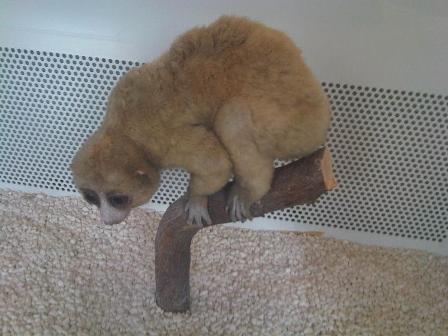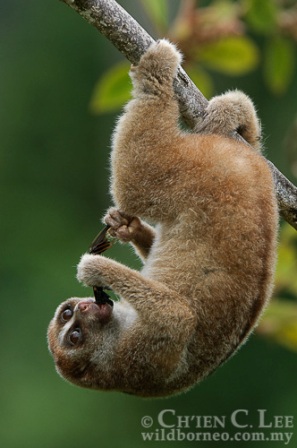
Adaptation
A slow loris has advanced olfactory communication that can help it communicate with other slow lorises. They can smell other slow loris markings and understand what they mean (territorial vs. problem).
Along with their smelling communication, they also are primates meaning they have opposable thumbs. These thumbs (on all four legs) help them grip branches. Slow lorises have specialized blood vessels that give extra oxygen to their muscles allowing them to hold onto trees for hours on end without getting tired.

This is extremely
important if there is a predator on the ground that they need to
avoid. Those blood vessels are mainly in the wrist and hands to
prevent muscle cramps, which increases the length of time that the
slow loris clings. Because their hind limbs and forelimbs are about
the same length, they can hang on with all four of their extensions
at a time.

Their flexible back also allows them to hang on at odd angles including upside down. Their slow movement is very distinctive to this species, but this unhurried movement could actually be a way that slow lorises avoid predators. They are very silent when they locomote. Their specific form of movement is quadrupedal (walking on all four legs) crawling.
Despite usually moving very slow, they can dramatically
increase the speeds that they move when a predator is attacking.
Slow lorises also have thick skin, so if they are attacked, the
teeth of the predator doesn’t sink in as much giving the slow loris
more of a chance to survive. A slow loris has many ways to avoid
getting attacked by a predator.

First, it has large, dark markings that make their huge eyes appear
even bigger, so nocturnal predators could get a glimpse of their
eyes while hunting and mistake it for a bigger animal. Other ways it
can avoid predators is through hiding, curling up in a defensive
position, and it can also mimic a cobra by putting its arms above
its head and swaying back and forth. (See
Adaptations)
If this doesn’t scare off a predator, its bite probably would; they
have venom that can be very painful if injected into the skin of a
predator. Not only do mature slow lorises have this venom, but they
also can transfer it to the fur of their babies through a
well-developed tooth comb, so they are safer from predators as well.
(See
Venom)
See what kinds of food a slow loris eats next at Nutrition!
To see how other organisms are adapted to their environment, go to MultipleOrganisms.net!
Back to Homepage